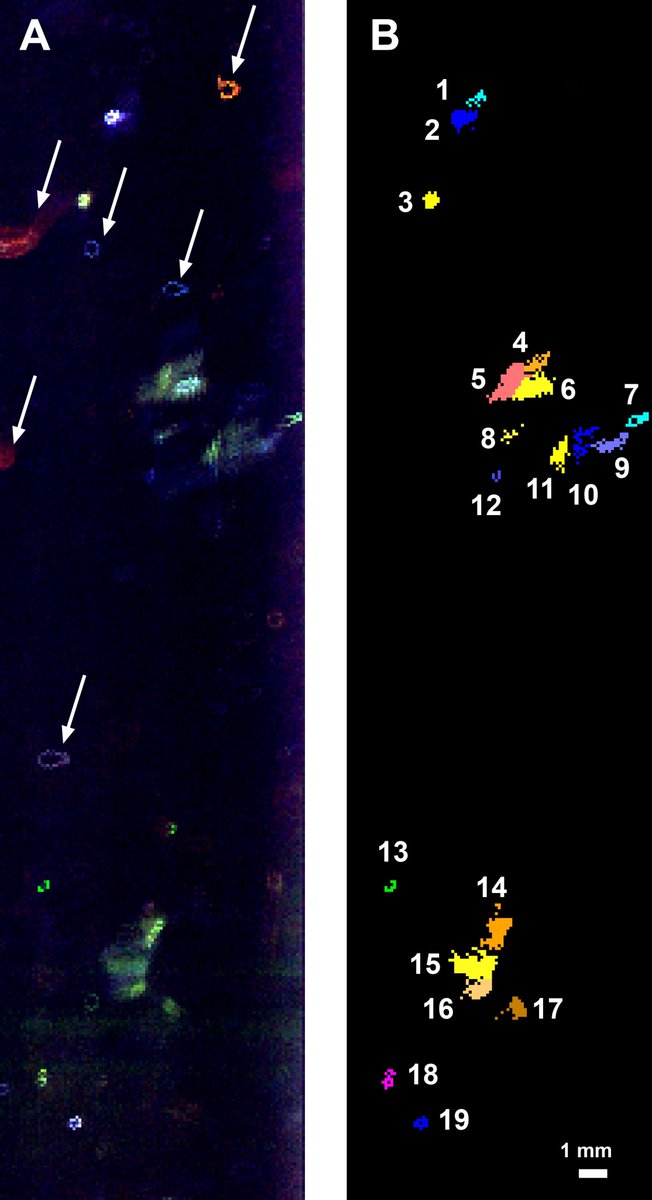So...here& #39;s a little science story. We drilled deep into the ice at Summit Station Greenland and saw stuff that glowed with a UV laser. Here is a pic in NASA& #39;s Planetary Photojournal: https://photojournal.jpl.nasa.gov/catalog/PIA24140">https://photojournal.jpl.nasa.gov/catalog/P...
See all those little spots and blotches? Yeah, we don& #39;t know exactly what they are. But we& #39;ve got spectra of all of them. Big mystery, right?
The different colors are different spectral responses. (so redder stuff glows redder - longer wavelength, bluer stuff glows bluer - shorter wavelength)
(y& #39;all can ignore the stuff indicated by arrows, those are on the instrument window.) We colored them and numbered them up.
(y& #39;all can ignore the stuff indicated by arrows, those are on the instrument window.) We colored them and numbered them up.
There was a really neat lecture organized by @arielwaldman. Here is a link, hopefully a recorded version will be posted up somewhere: https://twitter.com/SFMicroSociety/status/1384339688949903360?s=20">https://twitter.com/SFMicroSo...
In those talks there was a presentation by someone who collected micrometeorites. Tiny rocks from space that are everywhere. He finds them on roofs, but they also been found in a well at the South Pole. And in snow at Dome C in Antarctica.
You can see where I& #39;m goin& #39; with this...
You can see where I& #39;m goin& #39; with this...
So what are the chances that some of those little blobs we saw could be micrometeorites?
The typical micrometeorite size was about 200 microns across. That& #39;s pretty big. Most dust particles are on order of 1-2 microns.
We were at Summit, very far from blowing grains.
The typical micrometeorite size was about 200 microns across. That& #39;s pretty big. Most dust particles are on order of 1-2 microns.
We were at Summit, very far from blowing grains.
So here is a very recent paper we dug up (haha!) on micrometeorites from Dome C in Antarctica. https://reader.elsevier.com/reader/sd/pii/S0012821X21000534?token=6EAA32803DAE832701D64B6A7286D01DDEF48CB4E439A2C3258887F5C79B5245E3F0038FFC701098BE9967322F3AFD32&originRegion=us-east-1&originCreation=20210430030635">https://reader.elsevier.com/reader/sd...
From their numbers, a typical number is about 200 micrometeorites in about 700 kg of snow (=ice). Lets call it 700 L of water or 700,000 cm3 of ice. (about-ish)
So 1 micrometeorite every 3.5 L or 3,500 cm3.
So 1 micrometeorite every 3.5 L or 3,500 cm3.
That map above is about 1 cm x 4 cm and with our laser at that wavelength we probably see down about 1 cm deep too. So that is a volume of 4 cm3.
So we have about 1 in 1000 chance of having a micrometeorite in that scene.
So we have about 1 in 1000 chance of having a micrometeorite in that scene.
So unless we got super-lucky, we probably didn& #39;t see one. But....if we had, it would likely have a very long wave (red) fluorescence due to the aluminum and rare earth metals present.
So, great example of how a fun talk can make you go back and think about your research!
So, great example of how a fun talk can make you go back and think about your research!
[End thread]
(But..it makes us wonder if there were any mechanisms in the ice that could concentrate those particles (like an internal melt lens where embedded stuff could fall to bottom of melt lens), that would totally light up with our instrument! We can estimate that scale!)
(But..it makes us wonder if there were any mechanisms in the ice that could concentrate those particles (like an internal melt lens where embedded stuff could fall to bottom of melt lens), that would totally light up with our instrument! We can estimate that scale!)

 Read on Twitter
Read on Twitter


